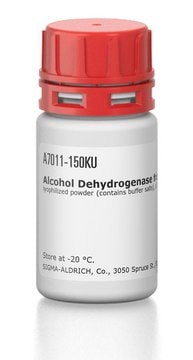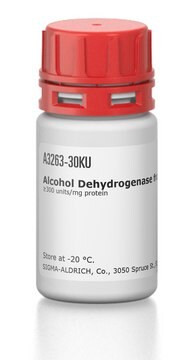55689
Alcohol Dehydrogenase equine
recombinant, expressed in E. coli, ≥0.5 U/mg
Synonyme(s) :
ADH
Se connecterpour consulter vos tarifs contractuels et ceux de votre entreprise/organisme
About This Item
Produits recommandés
Produit recombinant
expressed in E. coli
Niveau de qualité
Description
Isozyme E sequence
Forme
lyophilized powder
Activité spécifique
≥0.5 U/mg
Température de stockage
−20°C
Vous recherchez des produits similaires ? Visite Guide de comparaison des produits
Actions biochimiques/physiologiques
Alcohol dehydrogenase catalyzes the oxidative conversion of alcohol into aldehyde. It has a homodimeric structure with a co-enzyme binding domain at the C-terminal and an N-terminal catalytic domain. The active site is located at the interdomain cleft. Binding of NAD+ in the active site causes conformational changes which create the binding site for the alcohol substrate.
Définition de l'unité
1 U corresponds to the amount of enzyme which reduces 1 μmol benzaldehyde per minute at pH 7.0 and 30 °C.
Mention d'avertissement
Danger
Mentions de danger
Conseils de prudence
Classification des risques
Resp. Sens. 1
Code de la classe de stockage
11 - Combustible Solids
Classe de danger pour l'eau (WGK)
WGK 1
Point d'éclair (°F)
Not applicable
Point d'éclair (°C)
Not applicable
Faites votre choix parmi les versions les plus récentes :
Déjà en possession de ce produit ?
Retrouvez la documentation relative aux produits que vous avez récemment achetés dans la Bibliothèque de documents.
Ioanna A Gorbunova et al.
The journal of physical chemistry. B, 125(34), 9692-9707 (2021-08-20)
The dynamics of polarized fluorescence in NADH in alcohol dehydrogenase (ADH) in buffer solution has been studied using the TCSPC spectroscopy. A global fit procedure was used for determination of the fluorescence parameters from experiment. The interpretation of the results
Steven Hayward et al.
Biophysical journal, 91(5), 1823-1831 (2006-05-23)
Horse liver alcohol dehydrogenase is a homodimer, the protomer having a coenzyme-binding domain and a catalytic domain. Using all available x-ray structures and 50 ns of molecular dynamics simulations, we investigated the mechanism of NAD+-induced domain closure. When the well-known
Structure of a triclinic ternary complex of horse liver alcohol dehydrogenase at 2.9 A resolution.
H Eklund et al.
Journal of molecular biology, 146(4), 561-587 (1981-03-15)
F Colonna-Cesari et al.
The Journal of biological chemistry, 261(32), 15273-15280 (1986-11-15)
A study of the hinge bending mode in the enzyme liver alcohol dehydrogenase is made by use of empirical energy functions. The enzyme is a dimer, with each monomer composed of a coenzyme binding domain and a catalytic domain with
H Eklund et al.
Biochemistry, 23(25), 5982-5996 (1984-12-04)
The binding of NAD to liver alcohol dehydrogenase has been studied in four different ternary complexes by using crystallographic methods. These complexes crystallize isomorphously in a triclinic crystal form which contains the whole dimer of the enzyme in the asymmetric
Notre équipe de scientifiques dispose d'une expérience dans tous les secteurs de la recherche, notamment en sciences de la vie, science des matériaux, synthèse chimique, chromatographie, analyse et dans de nombreux autres domaines..
Contacter notre Service technique






